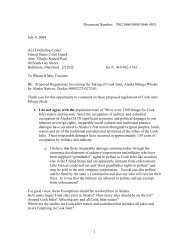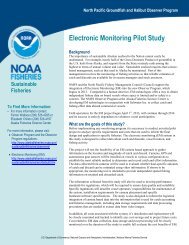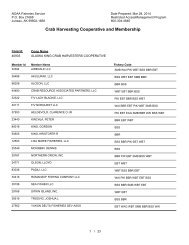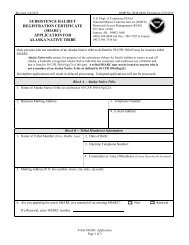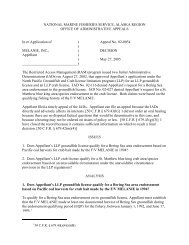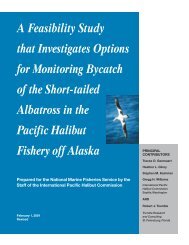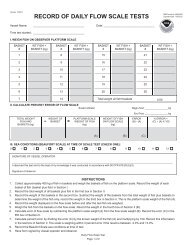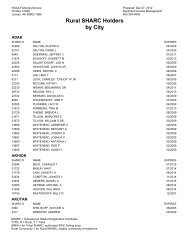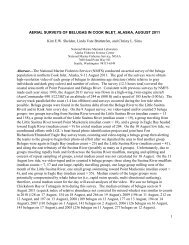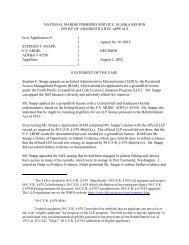A Feasibility Study that Investigates Options for Monitoring Bycatch of
A Feasibility Study that Investigates Options for Monitoring Bycatch of
A Feasibility Study that Investigates Options for Monitoring Bycatch of
Create successful ePaper yourself
Turn your PDF publications into a flip-book with our unique Google optimized e-Paper software.
The Pacific Halibut Fishery and GearHALIBUT FLEET PROFILEToday’s commercial halibut fishing fleet is diverse, using various types <strong>of</strong> longline gearand strategies to obtain its quarry. Both Alaska and British Columbia have implemented anindividual quota (IQ) system <strong>that</strong> enables a vessel to fish anytime during an eight-month season,and thus play the market to their advantage. In addition, the IQ fisheries have had ramifications<strong>for</strong> the fishers themselves, the fishing grounds, and the gear used. In addition to its commercialappeal, halibut is also one <strong>of</strong> the most popular sport fish targets, as seen by the still increasingcharter boat industry.The type <strong>of</strong> gear used to commercially fish <strong>for</strong> halibut haschanged little over the years. In the early years, a number <strong>of</strong> lines, each300 feet in length, were spliced end to end to <strong>for</strong>m the groundline. Thenumber <strong>of</strong> lines varied considerably, but most fishers eventually adoptedthe 6-line (1,800 feet) skate. Groundline is now sold in 1,800-footlengths. The interval between hooks, or “rig” <strong>of</strong> the gear, varies fromthree feet if the gear is used to also fish sablefish (Anoplopoma fimbria),to as much as 42 feet depending on gear and fishing target. Most fisherstargeting halibut use gear rigged 12 to 18 feet. Fishers set multiple skatestied together to <strong>for</strong>m a string <strong>of</strong> gear. Halibut fishers use three types <strong>of</strong>longline gear: conventional gear, snap gear, and autoline gear.Conventional gear consists <strong>of</strong> gangions (branch lines with hooks) tied tothe groundline. Traditionally, fishers coiled each skate to <strong>for</strong>m a bundle,held together with lanyards from canvas squares underneath the bundle<strong>that</strong> tied together on top (skate bottom gear). Recently, tub gear wasdeveloped when some fishers cut the groundline into smaller sections,IPHC photoand coiled them into tubs. Snap gear consists <strong>of</strong> groundline wrapped onto a drum. Gangions snaponto and <strong>of</strong>f the groundline. Autoline gear consists <strong>of</strong> groundline and gangions retrieved and setfrom a machine <strong>that</strong> stores the gear.In 1982 and 1983 halibut fishers converted to circle-shaped hooks from the traditional J-shaped hooks. IPHC studies indicate <strong>that</strong> circle hooks are two to three times more efficient atcatching halibut than its J-hook counterpart, depending on fish size. The reason <strong>for</strong> this is betterhooking qualities, as well as lower escape rates once the fish are on the hooks. Large hooks aremost commonly used when targeting halibut exclusively and smaller hooks are more commonwhen simultaneously targeting other species such as sablefish.Fishers typically set gear in the morning, and retrieve gear through the day into theevening. Soak time ranges from a few hours to 24 hours, but averages around 12 hours. Settinggear occurs in approximately the same way <strong>for</strong> the three types <strong>of</strong> longline gear (Fig. 2). Fishersthrow over a buoy and flag attached with running line to an anchor. The groundline is attached tothe anchor with a short running line. Resistance <strong>of</strong> gear in the water pulls the groundline withbaited hooks over the stern <strong>of</strong> the moving vessel <strong>for</strong> conventional and autoline gear. The rotatingdrum pays out line <strong>for</strong> snap gear. For most vessels, the groundline falls quickly to the waterbehind the vessel and gradually sinks below the surface. Baits sink below the diving depth <strong>of</strong>seabirds within several hundred feet behind the vessel. An anchor and pole and flag on the otherend <strong>of</strong> the groundline complete the set.8



